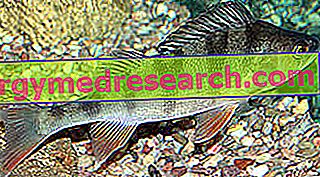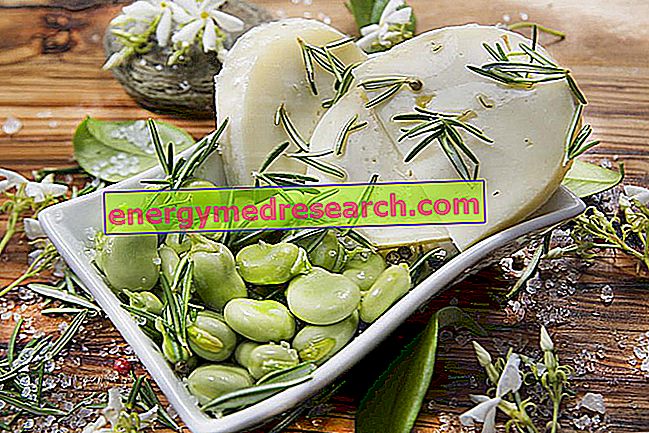Disambiguation
The term "Persian" is used to call different edible freshwater fish, even quite different from each other. The best known from the commercial point of view are the perch ( Perca fluviatilis ), the African perch (or perch of the Nile - Lates niloticus ) and the bass perch ( Morone saxatilis X Morone chrysops ). Furthermore, three other fish common in Italian waters (albeit of an allochthonous nature) include the noun "perch" in their common name, these are: largemouth bass, sun bass, pike-perch (perch).
Royal Perch
Of all those mentioned, the perch ( Perca fluviatilis ) is the only Italian native species. This fish populates mainly inland waters, but has discrete euryhaline capacities (it supports significant variations in the degree of water salinity).

The perch does not reach remarkable dimensions (very rarely it reaches 50cm). It has an oval body with a rather arched shape; the head is of considerable size. The color is green on the back and continues in straight or Y-shaped grooves towards the belly; the side is yellow and fades on the stomach. The ventral, anal and caudal fins are yellow and reddish; the others tend to greenish.
The perch feeds on plankton, fish, crustaceans, worms, larvae and insects (based on age); it is cannibalistic and preyed upon by other fish, reptiles and birds. It is not considered among the Species at risk, even if, except for the lakes, its population density has been heavily affected by the reduction of the algal vegetation and the introduction of alien aquatic creatures (eg the pike perch).
The perch is one of the TYPICAL fishing products of our inland waters; fished professionally, especially in larger lakes (such as Garda, Como and Maggiore), it is cooked for dishes such as grilled or fried fillets. However, having the patience to carefully push it, an extremely delicious risotto can be made from the perch. Other typical preparations are the Tuscan "brustico" and the "carpione" alla gardesana.
Paradoxically, there is no accurate nutritional information describing the nutritional intake of real perch. During cooking there is an extreme thinness of the fabrics, which tend to dry quickly; it is no coincidence that, in certain areas, for the grilling of real perch is chosen to use cane wood (notoriously not very calorific and which is consumed quickly).
African Perch - of the Nile
The Nile perch ( Lates niloticus ) is a freshwater creature that, despite being African, is very present on the national fish market. It frequents waters that are not very agitated and not too deep. It reaches very high dimensions (up to 2m per 200kg) and is characterized both by the size of the jaws and by the very well developed rump.

The African perch resembles "vaguely" real perch, but the coloring is totally brown-greyish with greater pallor than the belly. It is a predator that feeds on plankton, insects, other invertebrates and fish (based on age). It is considered one of the most harmful and invasive species on the planet, a feature highlighted by its introduction into Lake Victoria (for breeding purposes).
It is not a species at risk, far from it! Fishing is intensive but the Species seems to be able to withstand pressure easily. The Nile perch is extremely easy to clean, as it has only a backbone and ventral bones. Among the most popular recipes, breaded and baked fillets stand out; it is also cooked on the grill and in the pan, but its taste is always rather "anonymous". The quality of the Nile perch is absolutely not comparable to that of the perch but, thanks to the low price and the ease of preparation, today it represents one of the most sold fish in Italy.
From the nutritional point of view, the African perch has a very lean meat, therefore low calorie. Energy is essentially provided by high biological value proteins, while lipids and carbohydrates are absolutely marginal. Cholesterol is not negligible.
Among the mineral salts there are no noteworthy values and, as far as vitamins are concerned, niacin (vit. PP) and calciferol (vit. D) are not lacking.
Sea Bass Perch
Sea bass is an American fish. In Italy, the term "perch" means "palmetto", meaning the intersection of M. saxatilis and M. chrysops ; on the contrary, M. saxatilis is better known as "striped-bass". The latter reaches considerable dimensions (the larger ones also 2m for 40kg); it is elongated in shape, has a typical predatory jaw and its color is silver-gold with dark longitudinal streaks on the sides.

NB . Pigmentation varies considerably according to one or the other species. It feeds mainly on plankton, fish, worms, molluscs and crustaceans (based on age). It has strong euryhaline capacities, so much so that it easily colonizes both fresh and salt water, without necessarily carrying out annual migrations for reproduction. Palmetto (or perch bass from the fish market) has extremely rapid physical growth.
Despite the pressure of American professional fishing is rather pressing, the striped-bass is NOT an Endangered Species; in Europe, the palmetto herds are already quite widespread and mainly aimed at human nutrition and sport fishing. Some specimens have also been found in captivity. From a gastronomic point of view, striped-bass is considered extremely delicious (although the quality of the meat depends very much on the growing environment); that of the sea represents the alter ego of our sea bass. At the same time, the palmetto of breeding (rather inexpensive) does not have the same quality. The suitable cooking methods are those that do not dry the meat too much, then the foil, the oven, the frying pan and the boiling.
As regards the nutritional aspect, the bass perch is low in calories and rather low in lipids. Compared to the African perch, it has a slightly different distribution of fatty acids and a slightly poorer vitamin profile.
Citrus Perch
X Problems with video playback? Reload from YouTube Go to Video Page Go to Video Recipes Section Watch the video on youtubePerch Fish - Nutritional Values
 | |||||
| African perch | Perch Spigola | ||||
| Edible part | 100% | 100% | |||
| water | 80.0g | 79.2g | |||
| Protein | 15.4g | 17.7g | |||
| Prevailing amino acids | - | - | |||
| Limiting amino acid | - | - | |||
| Lipids TOT | 1.3g | 2.0g | |||
| Saturated fatty acids | 0.33g | 0.51g | |||
| Monounsaturated fatty acids | 0.28g | 0.66g | |||
| Polyunsaturated fatty acids | 0.64g | 0.78g | |||
| Cholesterol | 70.0mg | 80.0mg | |||
| TOT Carbohydrates | 2.0g | 0.0g | |||
| Glycogen | 2.0g | 0.0g | |||
| Soluble sugars | 0.0g | 0.0g | |||
| Dietary fiber | 0.0g | 0.0g | |||
| Soluble fiber | 0.0g | 0.0g | |||
| Insoluble fiber | 0.0g | 0.0g | |||
| Power | 80.8kcal | 88.8kcal | |||
| Sodium | 92.0mg | 69.0mg | |||
| Potassium | - mg | 256.0mg | |||
| Iron | 0.90mg | 0.84mg | |||
| Football | 23.0mg | 23.0mg | |||
| Phosphorus | 200.0mg | 198.0mg | |||
| Thiamine | 0.07mg | 0.10mg | |||
| Riboflavin | 0.10mg | 0.03mg | |||
| Niacin | 2.90mg | 2.10mg | |||
| Vitamin A | 9.0 RAE | 27.0 RAE | |||
| C vitamin | 2.00mg | 0.0mg | |||
| Vitamin E (alpha-tocopherol) | 0.20mg | 0.00mg | |||



